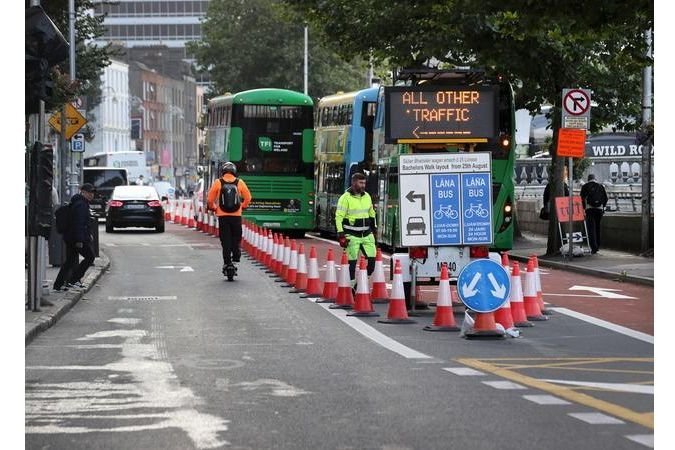
Traffic Laws in Ireland
Traffic laws in Ireland are designed to ensure safety, order, and accessibility on the country’s roads for drivers, cyclists, and pedestrians alike. In 2025, significant updates were introduced, including reduced speed limits, enhanced camera enforcement, and stricter penalties. Understanding traffic laws in Ireland is essential for anyone using the roads—whether you’re driving, cycling, or walking.
Speed Limits and Recent Changes
A key update to traffic laws in Ireland in 2025 was the reduction of speed limits across various road types. National secondary roads now have a limit of 80 km/h, down from 100 km/h. Local and rural roads dropped to 60 km/h from 80 km/h, and urban areas—such as town centres and residential zones—saw limits reduced from 50 km/h to 30 km/h. A new 60 km/h rural speed limit sign was introduced for minor roads.
These changes aim to reduce road fatalities and injuries, particularly on rural routes where high-speed crashes have been most common. This national reform is part of the Road Traffic Act 2024 and the Speed Limit Review, and all adjustments are being rolled out with updated signage.
Speed Cameras, Enforcement, and Penalties
As part of the evolving traffic laws in Ireland, camera enforcement has greatly expanded. Average speed cameras—now active on routes like the Dublin Port Tunnel, M7, N2, N3, and N5—monitor speeds over stretches of road. Drivers exceeding limits between two camera points face a €160 fine and three penalty points. Fixed and mobile speed cameras remain common, and red-light cameras have been added in many urban areas. These efforts reflect the government’s focus on preventing dangerous driving and improving road safety through stricter enforcement of traffic laws in Ireland.
Penalty Points System
A key aspect of traffic laws in Ireland is the penalty points system. Drivers committing offences—such as speeding, using a mobile phone, or not wearing a seatbelt—receive points on their licence. Accumulating 12 points within three years results in a six-month driving ban. For learner permit holders and novice drivers (with a licence for under two years), the threshold is only seven points. Points are recorded in a national database, and notices are sent by post. If fines are not paid within 28 days, the amount increases. Unpaid fines after 56 days result in court proceedings.
Licensing, Insurance, and Documentation
Traffic laws in Ireland require that all drivers hold a valid driving licence, insurance, road tax, and an NCT (National Car Test) if applicable. EU/EEA licence holders can drive in Ireland until their current licence expires, after which it must be exchanged. UK licences can also be exchanged without additional testing. Non-EU drivers can use their licence for up to 12 months, but must apply for an Irish licence for longer stays. From March 2025, new rules require drivers to submit their licence number when purchasing insurance—an anti-fraud measure introduced under updated traffic laws in Ireland.
Key Traffic Laws and Road Rules
- Seatbelts: All passengers must wear seatbelts. Non-compliance results in fines and penalty points.
- Mobile Phones: Using a phone while driving is illegal unless you’re using a hands-free system.
- Drink and Drug Driving: Legal blood alcohol limits are strict—0.05% for most drivers, 0.02% for learners and professionals.
- Child Safety: Children under 150 cm or 36 kg must use suitable child seats.
- Traffic Signals: Running a red light is a serious offence with camera-backed enforcement in place.
- Cyclists and Pedestrians: Drivers must leave at least 1.5m of clearance when passing cyclists on roads over 50 km/h, and 1m on roads below. Yielding at pedestrian crossings is mandatory.
- Toll Roads: Toll charges apply on specific roads and must be paid to avoid fines.
- Roundabouts: Yield to traffic coming from the right, unless signage indicates otherwise.
Road Signs and Markings
Understanding road signs is a crucial part of following traffic laws in Ireland. Regulatory signs (circular) indicate legal requirements like speed limits. Warning signs (yellow diamonds) alert drivers to hazards like curves or pedestrian crossings. Information signs (rectangular) provide navigation and local data. Road markings also enforce traffic laws—solid lines restrict overtaking, while broken lines allow it. All measurements are in kilometres and km/h.
Tips for Newcomers and International Drivers
If you’re new to driving under traffic laws in Ireland, consider the following:
- Drive on the left: This is a fundamental rule.
- Understand local signs: Irish road signs may differ from those in your home country.
- Prepare for rural roads: Many are narrow, winding, and may require cautious driving.
- Respect pedestrian crossings: Failing to stop can lead to fines.
- Park legally: Only park in marked spaces. Illegal parking, especially in disabled bays, can lead to clamping or fines.
- Be weather aware: Rain, fog, and ice are common—adjust driving accordingly.
- Use public transport in cities: Driving and parking can be challenging in urban areas.
New Educational and Enforcement Measures
New educational programs are being added to the broader framework of traffic laws in Ireland. For low-level offences, re-education courses may be offered in place of penalty points. These programs aim to reduce repeat offences through improved understanding. Graduated penalties are also under review, potentially leading to tougher consequences for repeat violators. With technology becoming a core part of enforcement, the use of cameras is expected to increase nationwide, supporting the broader goals of road safety.
Conclusion
Traffic laws in Ireland are continuously evolving to prioritise public safety. The 2025 reforms—lower speed limits, expanded camera systems, stricter penalties, and greater driver education—are all aimed at reducing fatalities and accidents. For residents and newcomers alike, knowledge of traffic laws in Ireland is essential for safe, lawful driving. Always carry your documentation, obey signs and speed limits, drive with caution, and stay updated with any legislative changes. By respecting traffic laws in Ireland, you help ensure safer journeys for everyone on the road.
- See also: Public transport in Ireland